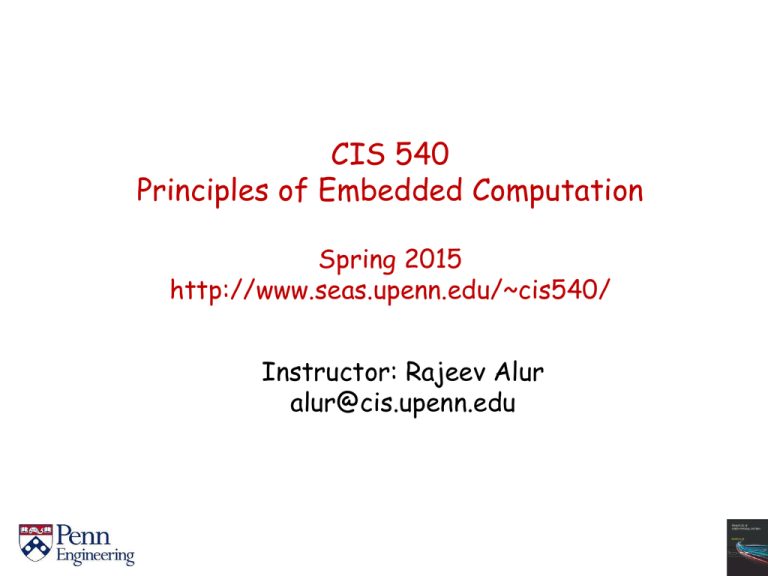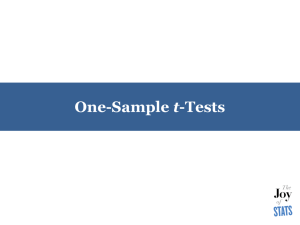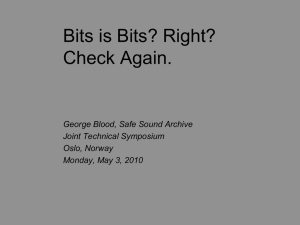Slides
advertisement

CIS 540
Principles of Embedded Computation
Spring 2015
http://www.seas.upenn.edu/~cis540/
Instructor: Rajeev Alur
alur@cis.upenn.edu
Asynchronous Models
Recap: In a synchronous model, all components execute in a sequence of
(logical) rounds in lock-step
Asynchronous: Speeds at which different components execute are
independent (or unknown)
Processes in a distributed system
Threads in a typical operating system such as Linux/Windows
Key design challenge: how to achieve coordination?
CIS 540 Spring 2015; Lecture Feb 18
Example: Asynchronous Buffer
bool in
{0,1,null} x := null
bool out
Ai: x := in
Ao: x != null { out:=x; x:=null}
Input channel: in of type Boolean
Output channel: out of type Boolean
State variable: x; can be empty/null, or hold 0/1 value
Initialization of state variables: assignment x:=null
Input task Ai for processing of inputs: code: x:= in
Output task Ao for producing outputs:
Guard: x != null; code: out:=x; x:=null
CIS 540 Spring 2015; Lecture Feb 18
Example: Asynchronous Buffer
{0,1,null} x := null
bool in
bool out
Ai: x := in
Ao: x != null { out:=x; x:=null}
Execution Model: In one step, only a single task is executed
Processing of inputs (by input tasks) is decoupled from production
of outputs (by output tasks)
A task can be executed if it is enabled, i.e., its guard condition holds
If multiple tasks enabled, one of them is executed
Sample Execution:
null
in?0
out!0
0
in?1
null
in?0
1
out!0
0
CIS 540 Spring 2015; Lecture Feb 18
null
Example: Asynchronous Increments
nat x:=0; y:=0
Ax: x := x+1
Ay: y :=y+1
Internal task: Does not involve input or output channels
Can have guard condition and update code
Execution of internal task: Internal action
In each step, execute, either task Ax or task Ay
Sample Execution:
(0,0) (1,0) (1,1) (1,2) (1,3) … (1,105) (2, 105) …
For every m, n, state (x=m, y=n) is reachable
Interleaving model of concurrency
CIS 540 Spring 2015; Lecture Feb 18
Asynchronous Merge
msg in1
queue(msg) x1 := null; x2 := null
A1: ~Full(x1) Enqueue(in1, x1)
msg out
A2: ~Full(x2) Enqueue(in2, x2)
msg in2
B1: ~Empty(x1) out := Dequeue(x1)
B2: ~Empty(x2) out := Dequeue(x2)
Sequence of messages on output channel is an arbitrary merge
of sequences of values on the two input channels
CIS 540 Spring 2015; Lecture Feb 18
Asynchronous Merge
msg in1
queue(msg) x1 := null; x2 := null
A1: ~Full(x1) Enqueue(in1, x1)
msg out
A2: ~Full(x2) Enqueue(in2, x2)
msg in2
B1: ~Empty(x1) out := Dequeue(x1)
B2: ~Empty(x2) out := Dequeue(x2)
At every step exactly one of the four tasks executes,
provided its guard condition holds
Sample Execution:
([],[]) – in1?5 -> ([5], []) – in2?0 -> ([5],[0]) – out!0 -> ([5],[])
– in1?6 -> ([5,6],[]) – in2?3 -> ([5,6],[3]) – out!5 -> ([6],[3]) …
CIS 540 Spring 2015; Lecture Feb 18
What does this process do?
int in1
int+null x1 := null; x2 := null
A1: x1 = null x1 := in1
A2: x2 = null x2 := in2
int in2
B: (x1 != null) & (x2 != null)
{ out := x1 + x2;
x1 := null; x2 := null }
CIS 540 Spring 2015; Lecture Feb 18
int out
Definition: Asynchronous Process P
Set I of (typed) input channels
Defines the set of inputs of the form x?v, where x is an input
channel and v is a value
Set O of (typed) output channels
Defines the set of outputs of the form y!v, where y is an output
channel and v is a value
Set S of (typed) state variables
Defines the set of states QS
Initialization Init
Defines the set [Init] of initial states
CIS 540 Spring 2015; Lecture Feb 18
Definition (contd): Asynchronous Process P
Set of input tasks; each such task is associated with an input channel x
Guard condition over state variables S
Update code from read-set S U {x} to write-set S
Defines a set of input actions of the form s – x?v -> t
Set of output tasks; each task is associated with an output channel y
Guard condition over state variables S
Update code from read-set S to write-set S U {y}
Defines a set of output actions of the form s – y!v -> t
Set of internal tasks
Guard condition over state variables S
Update code from read-set S to write-set S
Defines a set of internal actions of the form s – e -> t
CIS 540 Spring 2015; Lecture Feb 18
Asynchronous Gates
bool in
bool out
Why design asynchronous circuits?
Input can be changed even before the effect propagates through
the entire circuit
Can be faster than synchronous circuits, but design more complex
Modeling a NOT gate
When input changes, gate enters unstable state till it gets a chance
to update output value
If input changes again in unstable state, then this causes a hazard
where behavior is unpredictable
CIS 540 Spring 2015; Lecture Feb 18
Asynchronous NOT Gate as an ESM
Sample Execution:
(stable,0) – out!0 -> (stable,0) – in?0 -> (unstable,0) –e-> (stable, 1) – out!1 ->
(stable,1) – in?1 -> (unstable,1) –out!1 -> (unstable,1) – in?0 -> (hazard,1) – out!0
-> (hazard,1) – out!1 -> (hazard,1) …
How to ensure that the gate does not enter hazard state?
When the input toggles, wait to observe a change in value of output!
CIS 540 Spring 2015; Lecture Feb 18
Executing an ESM
Each mode-switch corresponds to a task
Example input task: (mode = stable) if (in=x) then mode := unstable
Example output task: (mode = stable) out := x
Example internal task: (mode = unstable) { x:=~x; mode := stable }
CIS 540 Spring 2015; Lecture Feb 18
Block Diagrams
Visually the same as the synchronous case
Execution semantics different !
CIS 540 Spring 2015; Lecture Feb 18
DoubleBuffer
Buffer2
Buffer1
bool in
bool temp
bool out
( Buffer[out -> temp] | Buffer[in -> temp] ) \ temp
Instantiation: Create two instances of Buffer
Output of Buffer1 = Input of Buffer2 = Variable temp
Parallel composition: Asynchronous concurrent execution of Buffer1
and Buffer2
Hide variable temp: Encapsulation (temp becomes local)
CIS 540 Spring 2015; Lecture Feb 18
Composing Buffer1 and Buffer2
Buffer2
Buffer1
bool in
{0,1,null} x1 := null
A1i: x1 := in
{0,1,null} x2 := null
bool temp
bool out
A2i: x2 := temp
A1o: (x1 != null)
{ temp:=x1; x1:=null}
A2o: (x2 != null)
{ out:=x2; x2:=null}
Inputs, outputs, states, and initialization for composition obtained in
the same manner as in synchronous case
What are the tasks of the composition?
Production of output on temp by Buffer1 synchronized with
consumption of input on temp by Buffer2
CIS 540 Spring 2015; Lecture Feb 18
Compiled DoubleBuffer
Buffer2
Buffer1
bool in
{0,1,null} x1 := null
A1i: x1 := in
A1o: (x1 != null)
{ temp:=x1; x1:=null}
{0,1,null} x2 := null
bool temp
A2i: x2 := temp
A2o: (x2 != null)
{ out:=x2; x2:=null}
{0, 1, null} x1 := null; x2 := null
A1i: x1 := in
bool in
A2o: (x2 != null) {out:=x2; x2:=null}
B (A1o + A2i): (x1 != null)
{ local bool temp
temp:=x1; x1:=null; x2:= temp }
CIS 540 Spring 2015; Lecture Feb 18
bool out
bool out
Definition of Asynchronous Composition
Given asynchronous processes P1 and P2, how to define P1 | P2 ?
Note: In each step of execution, only one task is executed
Concepts such as await-dependencies, compatibility of interfaces,
are not relevant
Sample case (see textbook for complete definition):
if y is an output channel of P1 and input channel of P2, and
A1 is an output task of P1 for y with code: Guard1 Update1
A2 is an input task of P2 for y with code: Guard2 Update2, then
Composition has an output task for y with code:
(Guard1 & Guard2) Update1 ; Update2
CIS 540 Spring 2015; Lecture Feb 18
Execution Model: Another View
A single step of execution
Execute an internal task of one of the processes
Process input on an external channel x: Execute an input task for x of
every process to which x is an input
Execute an output task for an output y of some process, followed by an
input task for y for every process to which y is an input
If multiple enabled choices, choose one non-deterministically
No constraint on relative execution speeds
CIS 540 Spring 2015; Lecture Feb 18
Asynchronous Merge
Merge
queue(msg) x1 := null; x2 := null
msg in1
A1: ~Full(x1) Enqueue(in1, x1)
msg out
A2: ~Full(x2) Enqueue(in2, x2)
msg in2
B1: ~Empty(x1) out := Dequeue(x1)
B2: ~Empty(x2) out := Dequeue(x2)
Merge1
msg in1
Merge2
msg temp
msg out
msg in2
msg in3
CIS 540 Spring 2015; Lecture Feb 18









